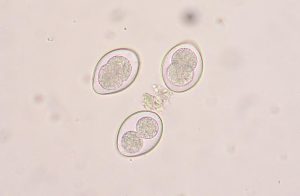The Florida cattle industry is a big business, ranked 9th in the U.S. in 2023, and is growing. Several of the country’s top ten cattle cow-calf ranches are in Florida. A healthy herd is a productive herd. Coccidiosis is an illness that can drastically affect a herd’s health. Coccidiosis is a severe disease in cattle, sheep, goats, swine, poultry, and rabbits, in which the liver and intestine may be affected. It is less often diagnosed in dogs, cats, and horses but may result in a severe illness. This article will discuss coccidiosis, its effects, and what treatment and prevention can be used for cattle.
What is coccidiosis in cattle?

Coccidiosis is an intestinal parasitic disease caused by a protozoan named Eimeria ssp. (Coccidia), usually in calves or older cattle. An animal can have Coccidia and not have any symptoms. There are 13 species of Coccidia associated with the clinical coccidiosis disease. Most cattle are infected with Coccidia and shed eggs in their feces. Eggs hatch in warm and moist environments after a few days or months and become infectious when they hatch. The eggs are ingested by calves when they consume contaminated pastures, feed, water, or lick a dirty hair coat. Once ingested, the life cycle begins again and repeats. Using proper treatment and prevention will break the life cycle. Coccidia can cause subtle or severe illnesses, causing stress and debilitation of the cattle, resulting in secondary diseases that further jeopardize the health of the animal and could even cause death.
Symptoms to look for:
Symptoms of coccidiosis usually present as acute diarrhea with or without blood, straining, severe weight loss, dehydration, and an unthrifty appearance. Clinical signs typically occur about 17 days after ingestion but vary based on the animal’s age. Clinical signs diagnose coccidiosis and fecal examination by flotation or smear.
Treatment and Prevention:
Isolate the sick cattle to prevent increased contamination of the premises. The life cycle of Coccidia is self-limiting within a few weeks if continuous reinfection does not occur. Medications such as Corid, Bovatec, or Rumensin may shorten the course of infection, reduce the discharge of eggs, and alleviate bleeding and diarrhea. Isolate the sick animal(s) to prevent increased contamination of other animals. Maintaining a clean and dry environment, separating different age groups of cattle, and providing proper nutrition can help reduce the risk of coccidiosis.
Final remarks:
Coccidiosis is a common disease in calves and can spread quickly. Breaking the life cycle of Coccidia is needed to prevent this disease’s transmission. Cattle owners need to work closely with a veterinarian to develop an effective prevention and treatment plan based on the specific conditions of their herd. Regular monitoring, prompt diagnosis, and appropriate intervention are crucial in managing coccidiosis in cattle.
Written by Keith Newman and Joe Walter
References
Andrews, A., (2022 Oct). Coccidiosis of Cattle. Merck Veterinary Manual. https://www.merckvetmanual.com/digestive-system/coccidiosis/coccidiosis-of-cattle
Richards, C., Step D.L., Giedt E.J., (2016 Oct). Coccidiosis Treatment and Prevention in Cattle. okstate.edu. https://extension.okstate.edu/fact-sheets/coccidiosis-treatment-and-prevention-in-cattle.html
Dedrickson, J., Coccidia Lifecycle. corid.com. https://www.corid.com/Coccidia.html
 0
0
